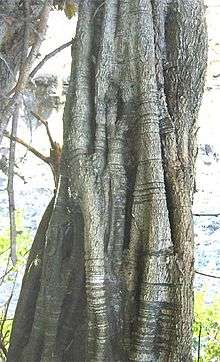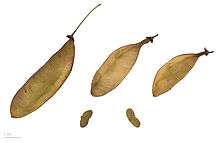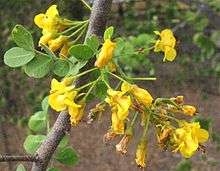Haematoxylum brasiletto
| Haematoxylum brasiletto | |
|---|---|
 | |
| Fluted trunk | |
| Scientific classification | |
| Kingdom: | Plantae |
| Clade: | Angiosperms |
| Clade: | Eudicots |
| Clade: | Rosids |
| Order: | Fabales |
| Family: | Fabaceae |
| Genus: | Haematoxylum |
| Species: | H. brasiletto |
| Binomial name | |
| Haematoxylum brasiletto H.Karst [1] | |
| Synonyms | |
|
Haematoxylum boreale S. Watson [2] | |

Haematoxylum brasiletto, or Mexican logwood, is a species of tropical hardwood tree in the legume family, Fabaceae. It is known in its native Mexico and Guatemala as "palo de brasil" or "palo de tinto". The timber is used to make bows for stringed instruments, the manufacture of dyes and in ethnobotany.[3]
Description

H. brasiletto is a small tree or large thorny shrub, seven to fifteen metres high. The trunk and larger branches are fluted and the heartwood is deep red. The tree has pinnate leaves with three pairs of heart-shaped leaflets and no terminal leaflet. The clusters of yellow flowers are typical of the Caesalpinioideae, with five distinct lobes, and are followed by copper-coloured seed pods that split laterally when ripe, rather than at the edge. The seeds are black and kidney-shaped.[4]
Distribution and habitat
H. brasiletto occurs in Mexico, Belize, Costa Rica, Guatemala, El Salvador, Honduras, Nicaragua and Colombia.[2] It grows in a range of habitats including deciduous tropical forests, xerophytic scrub and montane forests where it is associated with oak and pine.[5] It is found growing in desert scrub in Baja California in association with elephant trees (Bursera microphylla), the woodrose (Merremia aurea) and the large Cardón cactus (Pachycereus pringlei).[4]
Uses
The wood of this tree is used in the making of bows for stringed instruments.[3] The tree yields other valuable products and has been exported for several centuries. It was included in the London Pharmacopoeia of 1740, which listed logwood tea as being effective against tuberculosis and dysentery.[4] The heartwood is used to produce dye for wool and cotton cloth and a pink colouring used in pharmaceuticals and toothpaste. The pigments hematoxylin and hematein can be extracted and are complex phenols similar to bioflavonoids. Extracts of hardwood chips are used as remedies by the Tarahumara Indians.[4] Ethnobotanical uses mentioned in "Duke's Phytochemical and Ethnobotanical Databases" includes use as an astringent, a dentifrice, a refrigerant, for treating condyloma, erysipelas, fever, jaundice, inflammation and stomach pain.[6] An extract of boiled heartwood chips is reported to have antibiotic properties, to reduce fever, and to act as a tonic to strengthen the body.[5]
References
- ↑ Haematoxylum brasiletto H. Karst. Encyclopedia of Life. Retrieved 2011-08-21.
- 1 2 "Haematoxylum brasiletto". Germplasm Resources Information Network (GRIN). Agricultural Research Service (ARS), United States Department of Agriculture (USDA). Retrieved 2011-08-21.
- 1 2 WangBow. Retrieved 2011-08-21.
- 1 2 3 4 Logwood and Brazilwood: Trees That Spawned 2 Nations Retrieved 2011-08-21.
- 1 2 Palo de brasil Biblioteca digital de la Medicina Tradicional Mexicana. Retrieved 2011-08-21
- ↑ Duke's Phytochemical and Ethnobotanical Databases Retrieved 2011-08-21.